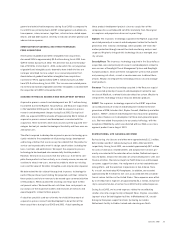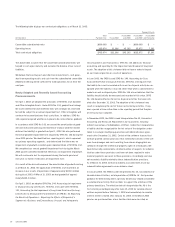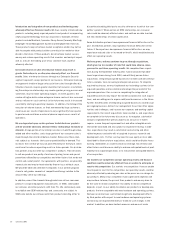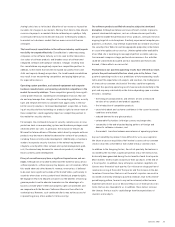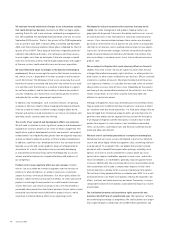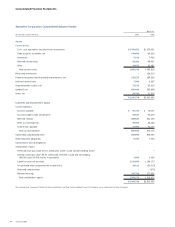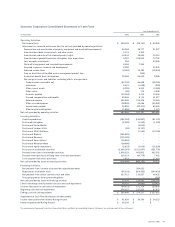Symantec 2003 Annual Report Download - page 40
Download and view the complete annual report
Please find page 40 of the 2003 Symantec annual report below. You can navigate through the pages in the report by either clicking on the pages listed below, or by using the keyword search tool below to find specific information within the annual report.
38 Symantec 2003
Introduction and integration of new products and technology may
adversely affect our financial results. We have recently introduced new
products, including newly acquired products and products incorporating
newly acquired technology from our acquisitions. Examples of these
products include ManHunt, Symantec Decoy Server (formerly ManTrap),
DeepSight Threat Management System and DeepSight Alert Services.
These products may not achieve market acceptance and/or may not be
able to compete with products either currently in the market or intro-
duced in the future. If these products do not achieve market success,
we may not achieve operating results that investors and analysts expect
and, as a result, the trading price of our common stock could be
adversely affected.
Increased reliance on sales of enterprise licenses may result in
greater fluctuations in, or otherwise adversely affect, our financial
results. Sales of enterprise licenses through our Enterprise Security
segment represent a major portion of our business. Enterprise licensing
arrangements involve a longer sales cycle than sales through other dis-
tribution channels, require greater investment of resources in establish-
ing the enterprise relationship, may involve greater pricing pressure and
sometimes result in lower operating margins. In recent quarters, the
number of higher dollar-value enterprise license contracts has increased
and our reliance on such contracts in the future may result in increased
uncertainty relating to quarterly revenues. In addition, the timing of the
execution of volume licenses, or their nonrenewal by large customers,
could cause our results of operations to vary significantly from quarter
to quarter and could have a material adverse impact on our results of
operations.
We are dependent upon certain partners to distribute our products
and we would be adversely affected if these relationships terminate or
diminish. A large portion of our enterprise sales is made through value-
added and other resellers, and a large portion of our consumer sales is
made through the retail distribution channel. Reliance on these chan-
nels subjects us to events that cause unpredictability in demand. This
increases the risk that we may not plan effectively for the future, which
could result in adverse operating results in future periods. Our distribu-
tion partners may also offer our competitors’ products. Their decisions
to sell our products are partly a function of pricing, terms and special
promotions offered by our competitors and other factors that we do not
control and cannot predict. Our agreements with partners are generally
nonexclusive and may be terminated by them or by us without cause.
We would be adversely affected if companies in our partner program
chose to sell greater amounts of competitive offerings relative to the
amount they sell of our offerings.
In addition, one of the channels through which we sell our consumer
products is original equipment manufacturers, or OEMs, who bundle
our antivirus and other products with their PCs. We continuously seek
to establish new OEM relationships and, conversely, are subject to
OEMs who bundle our software with their products deciding either to
discontinue bundling third party security software or to switch to a com-
petitor’s product. When we lose an OEM relationship, our consumer
sales could be adversely affected unless and until we are able to estab-
lish new relationships of similar significance.
Some distribution partners have experienced financial difficulties in the
past. Distribution partners may experience financial difficulties in the
future. If these partners do experience financial difficulties, we may
experience reduced sales or increased write-offs, which would adversely
affect our operating results.
We have grown, and may continue to grow, through acquisitions,
which give rise to a number of risks that could have adverse conse-
quences for our future operating results. We completed four acquisi-
tions during the September 2002 quarter, have announced two addi-
tional acquisitions during fiscal 2004, and will likely pursue future
acquisitions. Integrating acquired businesses has been and will continue
to be a complex, time consuming and expensive process. To integrate
acquired businesses, we must implement our technology systems in the
acquired operations and assimilate and manage the personnel of the
acquired operations. Our success in completing the integration of
acquired businesses may impact the market acceptance of such acquisi-
tions, and our willingness to acquire additional businesses in the future.
Further, the difficulties of integrating acquired businesses could disrupt
our ongoing business, distract our management focus from other oppor-
tunities and challenges, and increase our expenses and working capital
requirements. Our recent acquisitions have resulted in, and acquisitions
we complete in the future may also cause us to recognize, substantial
amounts of goodwill that will be subject to an annual, or if events
require, a more frequent impairment test and other intangible assets
that will be amortized and also subject to impairment testing. In addi-
tion, acquisitions may result in substantial restructuring and other
related expenses and write-offs of acquired in-process research and
development costs. Further, we may need to issue equity or incur addi-
tional debt to finance future acquisitions, which could be dilutive to our
existing stockholders or could increase our leverage. Any of these and
other factors could harm our ability to achieve anticipated levels of prof-
itability from acquired operations or to realize other anticipated benefits
of an acquisition.
Our markets are competitive and our operating results and financial
condition could be adversely affected if we are unable to anticipate or
react to this competition. Our markets are competitive. If we are unable
to anticipate or react to this competition, our operating results could be
adversely affected by reducing our sales or the prices we can charge for
our products. Many of our competitors have significantly lowered, and
may continue to lower, the price of their products and we may have to
do the same to remain competitive. Our ability to remain competitive
depends, in part, on our ability to enhance our products or develop new
products that are compatible with new hardware and operating systems.
We have no control over, and limited insight into, development efforts
by third parties with respect to new hardware and operating systems,
and we may not respond effectively or timely to such changes in the
market. In addition, we have limited resources and we must make







